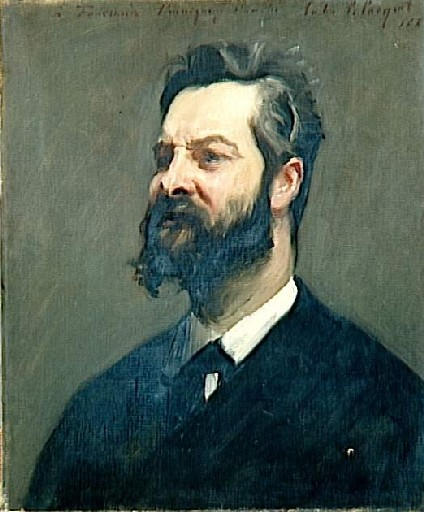
|

|
|
Fourcaud, Louis Boussess of (Beaumarchez, 1851 ~ 1914) Art critic, writer, poet, and finally professor of arts. By 1884, when Sargent paints him, he was writing for the Clairon (a daily newspaper) and other publications and was considered one of the prominent art critics in Paris -- he was 33 years old. Born of a noble family. At twelve he was informally schooled with the Jesuits of the college of Sainte-Marie in Toulouse in 1863. Formally started studies there in 1869 but gave it up in 1873 at the age of 22. He was attracted to the arts and literature and jumped into journalism by starting with some of the small provincial papers and then working himself up to the big show in Paris. His first real break came in March of 1876 when he wrote an article under a pen name of "George" for the Le Gaulois which was a well established daily devoted to literary, artistic and musical criticism. He continued writing for many years for them. In 1879 he collaborated in the Review Wagnerienne, a magazine about contemporary arts; and in 1881 wrote for the Clairon [1] and others papers. In 1893 he became a professor at
a school of the fine arts and would author many books and papers, primarily
devoted to architecture and painting.
The painting is a really interesting for a couple of reasons. First, we see Sargent was making the right kind of friends in the right places. People that can do him a lot of good. But secondly, it brings up the question
of when was this painted in 1884? Was it prior to the Salon? I don't mean
to denigrate the feelings of Sargent for I'm sure their friendship was
genuine, but in some ways you can almost see him sucking up to a critic;
or was this after the blowup at the Salon over Madame X? If the
painting was after, then I think we can infer a totally different mindset
to John. The inscription could easily imply a very heartfelt gratitude
towards a friend that stuck with him during a difficult period.
Notes:
Though a revolt was underway in the art world, the stalwarts who controlled the institutions were, for the most part, still of the old world. The patrons of the arts were often of nobility, though there was a growing middle class of republicans -- Manet, being an obvious example; and the Bohemians like Toulouse-Lautrec, Monet and Auguste Renoir. Sargent was apolitical, but he clearly
liked the association and connections which the upper classes gave him.
If he was going to play on the big stage and become known, then that was
the world in which he needed to move.
Bibliography Mount 844; Mac Kibbin p. 96; Bénédite 66; Catalogue summary illustrated paintings of the museum of the Louvre, II, Italy, Spain..., Paris, 1981, p. 70; Museum of Orsay, Catalogues summary illustrated paintings, Paris, 1990, II, p.415
|
